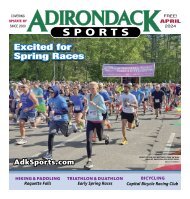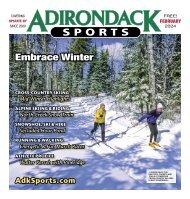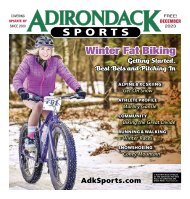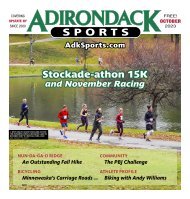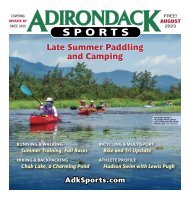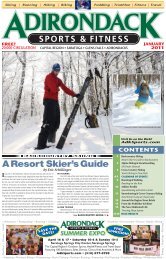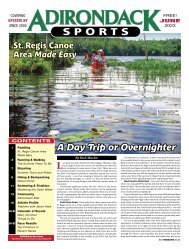Adirondack Sports April 2020
IN THIS ISSUE: BICYCLING Safe Riding RUNNING & TRIATHLON Staying Active and Healthy NEWS BRIEFS & FROM THE PUBLISHER PADDLING The Waterways Are Open, But… BICYCLING E-Bikes are Finding Their Place HEALTH & FITNESS Exercise for the Immune System ATHLETE PROFILE Running with Kevin Treadway CALENDAR OF EVENTS Canceled, Postponed, Virtual & Happening Events! RUNNING Running Life Resiliently NON-MEDICATED LIFE A Lifestyle Medicine Approach to Preventing Transmission of Covid-19 HEALTH & FITNESS Exercise for Cancer Survivors Living Without an Omentum RACE RESULTS Top Finishers in Recent Events MULTISPORT Travels of a Race T-Shirt
IN THIS ISSUE:
BICYCLING
Safe Riding
RUNNING & TRIATHLON
Staying Active and Healthy
NEWS BRIEFS & FROM THE PUBLISHER
PADDLING
The Waterways Are Open, But…
BICYCLING
E-Bikes are Finding Their Place
HEALTH & FITNESS
Exercise for the Immune System
ATHLETE PROFILE
Running with Kevin Treadway
CALENDAR OF EVENTS
Canceled, Postponed, Virtual & Happening Events!
RUNNING
Running Life Resiliently
NON-MEDICATED LIFE
A Lifestyle Medicine Approach to Preventing Transmission of Covid-19
HEALTH & FITNESS
Exercise for Cancer Survivors Living Without an Omentum
RACE RESULTS
Top Finishers in Recent Events
MULTISPORT
Travels of a Race T-Shirt
You also want an ePaper? Increase the reach of your titles
YUMPU automatically turns print PDFs into web optimized ePapers that Google loves.
10 <strong>Adirondack</strong> <strong>Sports</strong><br />
HEALTH & FITNESS<br />
PUSH BACKS ON ALL FOURS<br />
SINGLE ARM PULL DOWN<br />
Exercise for the Immune System<br />
SIDE STEPS<br />
BAND PRESS<br />
By Andrea Henkel Burke<br />
Physical activity is a key element when<br />
we want to maintain and improve our<br />
immune system. We can take care of<br />
having the best nutrients in our diet (and we<br />
should), but our built-in healthcare system<br />
is not complete, without moving our muscles<br />
and exercising frequently. You probably<br />
are reading <strong>Adirondack</strong> <strong>Sports</strong> because<br />
you are an active person. When I’m talking<br />
about athletes in this article, I mean basically<br />
everyone, whether you’re running or<br />
biking daily, or walking on a regular basis.<br />
I want you to know how different exercises<br />
affect your immune system in different<br />
ways. With this knowledge, you can design<br />
your workouts or activity depending on your<br />
situation, desire and goals.<br />
Cardio workouts – While moving our<br />
muscles, we activate natural killer cells,<br />
which keep working a couple of hours after<br />
our workout ends. The more natural killer<br />
cells that get activated, the better our<br />
immune system is able to fight any illness,<br />
including viruses. Activating these cells<br />
does not happen with every workout. In fact,<br />
depending on the intensity of our exercise,<br />
it also can suppress our immune system.<br />
When our training plan or exercise mood<br />
is asking for a high intensity anaerobic session,<br />
we need to be aware that our immune<br />
system will not be in its best condition after<br />
those workouts.<br />
Professional athletes and athletes with<br />
high performance goals, need those high<br />
impact workouts sometimes, as they need to<br />
stress their system in different ways in order<br />
to improve performance. The immune system<br />
of those athletes might be more often<br />
compromised than enhanced by this high<br />
impact training. That’s why they often, especially<br />
in competition season, use hand sanitizer,<br />
avoid big crowds, cinemas, and skip a<br />
party, no matter if there is a virus around or<br />
not. Over the years of training, they still created<br />
a better immune system, but it doesn’t<br />
show up all the time as virus protection. It<br />
often is busy with recovery from heavy workouts<br />
or big training blocks.<br />
Even when not racing, it’s healthy to trigger<br />
different metabolic systems by exercising<br />
the whole spectrum – from very slow/easy to<br />
very fast/hard. Slow and easy should still make<br />
up the majority of workouts. In the fitness<br />
world, you often see much less of a variety in<br />
training. I know, it doesn’t sound logical that<br />
slow or easy training sessions can improve<br />
performance, people often view them as a<br />
waste of time. Physiologically, slow sessions<br />
make a lot of sense and I highly encourage<br />
you to include those sessions for better performance,<br />
well-being and overall health.<br />
We all can use the time right now for setting<br />
up, improving or maintaining a great fitness<br />
foundation. I am obsessed with building<br />
and maintaining a solid base. You also<br />
would not start building a house without<br />
pouring a foundation. You probably heard<br />
before that our muscles can produce energy<br />
(ATP), with or without oxygen, also called<br />
aerobic or anaerobic. To build up our fitness<br />
base, and enhance our immune systems, we<br />
need to do aerobic sessions. Aerobic sessions<br />
are done at a lower intensity. In this<br />
training zone, our muscle cells use fat and<br />
carbohydrates to produce the energy we<br />
need for the workout.<br />
As soon as we switch into the anaerobic<br />
zone, fat is not getting burned anymore, and<br />
PULL DOWN<br />
our muscles rely only on carbohydrates to<br />
keep us going. This happens at high intensity.<br />
Depending on how well our aerobic system is<br />
trained determines when we enter the anaerobic<br />
zone. Those anaerobic sessions lead to<br />
stress for the body, which is wanted in some<br />
cases, but doesn’t support the immune system.<br />
I am not saying you should not work out<br />
in this zone at all, but right now it’s important<br />
to know that different training affects our<br />
ability to fight pathogens differently.<br />
We are able to train and extend our aerobic<br />
zone or fat metabolic system to support<br />
our immunity. Unfortunately, I cannot provide<br />
you with a formula, because everyone<br />
has their own metabolic system and everyone<br />
is able to change this system in six to<br />
eight weeks. Because of that, I usually offer<br />
a test, called Aeroscan, which shows specific<br />
and individual workout zones. Aeroscan<br />
accomplishes this by measuring how much<br />
fat and carbohydrates we are burning at<br />
a certain speed and heart rate. Some athletes,<br />
even trained ones, show very short fat<br />
burning zones, others have a very good fat<br />
burning metabolism, and can run relatively<br />
fast, while still supporting their immune






